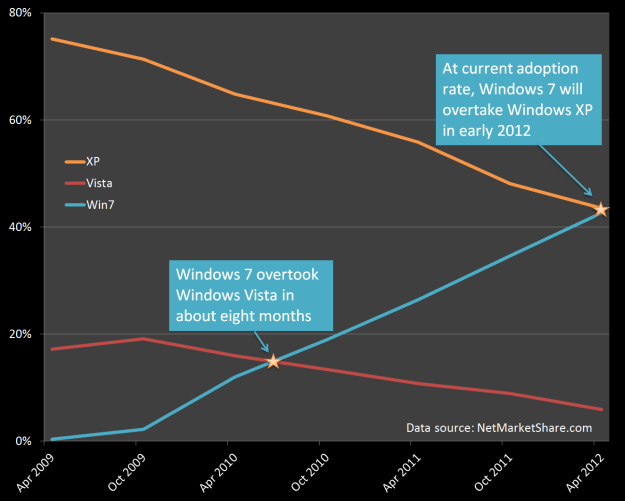Windows 7 continues to roll as XP fades away

Measuring the rate of adoption of various operating systems is always a tricky task, but some big trends are easy to spot no matter which metrics you use.
For Microsoft Windows, the markers are unmistakable: Windows XP continues its steady decline. Windows 7 continues its steady advance. Windows Vista is fading rapidly into a historical footnote.
This morning, StatCounter, a website analytics company, announced that more people are using Windows 7 than are using XP. I think they've jumped the gun a bit, but not by much.
For the last four years, every April and October, I've recorded statistics from another web analytics firm, Net Market Share, which publishes snapshots of PC usage based on data from 160 million visits per month to its large collection of sites (the exact methodology is here). The monthly reports on operating system versions provide an ideal snapshot for my purposes, with data that goes back far enough to see meaningful trends.
Here's the latest chart. It bears an uncanny resemblance to the numbers I projected more than a year ago:
A few facts are worth noting about these numbers.
The Net Market Share percentages represent web site visits, which includes a mix of business and consumer users. As such, they're a pretty good proxy for the market as a whole.
These trend lines illustrate how spectacularly Windows Vista failed in the marketplace. Vista hits its peak of usage, not surprisingly, in October 2009, the same month that Windows 7 was introduced. After three years on the market, it had not cracked the 20% mark—Windows 7 hit that number after only a year. As of October 2011, Vista's share has declined to 8.8%, and it will probably be below the 5% mark next year at this time.
By contrast, Windows 7 has reached roughly 35% share in just two years and shows no signs of slowing. I've drawn trend lines on this chart to estimate when the shares for Windows XP and Windows 7 will cross. That should be in about six months, although recent numbers suggest that Windows 7 is picking up steam.
As always, the overwhelming majority of copies of Windows are sold with new hardware. Windows users are retiring older PCs running Windows XP and replacing them with newer PCs running Windows 7. In September, Microsoft announced that Windows 7 had sold 450 million copies worldwide, at a pace that appears to be increasing as the operating system ages.
Finally, I'm always interested to see how Windows is faring against other, competing PC operating systems. Mac OS X worldwide continues to grind out an increasing share. In the past two years, it has gone from 5.3% to 6.9%. At that rate, the number of Macs will pass the number of PCs running Windows Vista sometime in 2012.
Meanwhile, Linux usage—as measured by web browsing activity—is still just a blip. But there are faint signs of growth: The 1.2% share for all distros of Linux is the highest level recorded by Net Market Share in the four years I've been keeping stats.
Windows XP is counting down to the day when it will no longer be supported in any fashion by Microsoft. According to the widget on my desktop, XP's end of life is exactly 888 days away—still too far out for anyone to panic.
Related posts:
- Can Windows 8 finally vanquish the ghosts of XP and Vista?
- Windows 7 finally beats XP, or does it?
- When will XP finally fade away?
- It's official: Windows 7 is a hit, and XP is finally in decline
- Businesses tell Microsoft "We're done with XP"
- Windows 7, one year later: How's Microsoft doing? And what's next?
